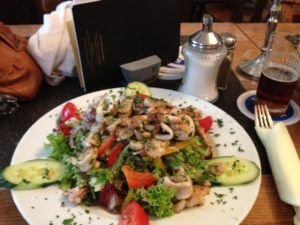I can travel a fair amount for my job. Anyone who travels on business has eaten alone in a restaurant. Some cringe. I don’t. Evening finds me in a restaurant, not eating grocery store finds in my hotel room.
That doesn’t mean that our society gets it. Asking for a table for one can elicit various reactions from the host – they’ve just found themselves down 50% at a table for two. A woman dining alone might also be seated at an inferior spot, thinking that she is embarrassed by her solitude. When waitstaff might ask me if I’d like to sit in a dark corner, next to the waitstaff station, or adjacent to the kitchen door, I refuse. Usually by the time I order, they know I mean business.
I definitely get stares. In Stockholm, I ate at The Pelikan – and incredible beer hall and local cooking establishment. I had an anchovy salad on brown bread, huge pork knuckle with three mustards and mashed swedes (nyuk nyuk) and two beers. Pity I can’t understand Swedish; I saw stares and murmuring from at least two other tables.
Don’t bring your newspaper, a book, or your iPhone to dinner. Dinner is about food, not reading. I sat next to a Canadian woman at Mathias Dahlgren’s Matbaren in the Grand Hotel in Stockholm. We both chose to dine well, and alone. She leaned over to me and pointed out a woman sitting crammed close to the end of the bar, picking at a salad and hiding behind her newspaper. “Isn’t that sad? Why would she come here, choose a boring salad, and not look around her?” (read more about my Stockholm trip here)
The waitstaff are programmed to think the independent diner wants to be served quickly and leave before you’ve been completely mortified by the experience of eating by yourself. Set the pace from the beginning.
- Spend a good deal of time with the menu. Enjoy not only selecting something for yourself to enjoy, but getting a feel for the restaurant by understanding what they offer.
- Order what’s local or unfamiliar to you. Don’t just eat to refuel, eat to learn.
- Look at your fellow diners. They are watching you, so there’s no reason why you shouldn’t watch them. This is especially appealing to writers.
- Spend longer talking to the waitstaff about the restaurant and the food. Not having to rush back to your conversation with a dining partner frees you up for a more exploratory, engaged, kind of dining experience – especially if you are a foodie. (Of course, I’m less successful at this in foreign countries where I don’t speak the language!)
I saw this in play at St. John in Clerkenwell. As I demonstrated my inquisitiveness (by ordering the bone marrow and parsley salad and the tripe in white wine and bacon) the waitstaff spoke more to me about what was going on at the restaurant and spent more time with me picking out wine and dessert.


[…] place. I like to sit at the bar (I saw several women tucked in out of the way booths – see my post on Eating Alone). My dinner companions and cheery bartender Kelly all had an eye roll after a lounge lizard […]